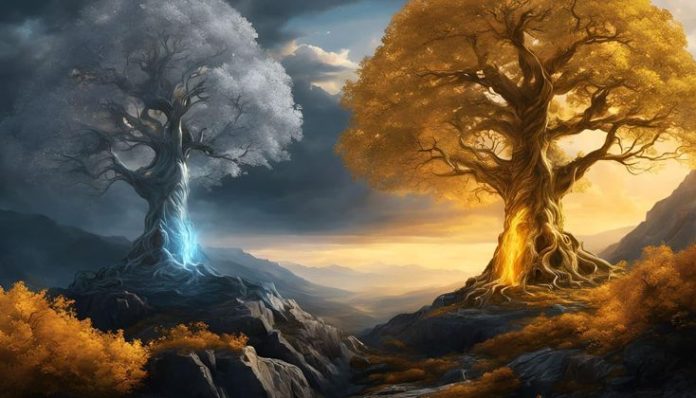Before the Sun rose, before the Moon lit the night, there were two trees. And they did more than give light.
They breathed beauty. They pulsed with memory. They held the rhythm of Arda’s first harmony — until they were wounded.
The Two Trees of Valinor — Telperion and Laurelin — are among the most profound symbols in Tolkien’s mythology. Their tale echoes far beyond their branches, flowing into the DNA of Middle-earth itself. But their secret meaning is not just mythic — it is deeply human.
Let us walk in their light.
1. The Trees Before the Sun: Light as Memory
Tolkien’s world begins in shadow and silence. When the Ainur first descend into Arda, it is a world unshaped — without sun, without moon.
So the Valar create a sacred space: Valinor, in the Blessed Realm. There, the Vala Yavanna, giver of fruits and guardian of growing things, sings life into two extraordinary trees:
- Telperion, the elder tree, with silver leaves that shimmer like dewlit frost.
- Laurelin, the younger, radiating golden warmth from her radiant blooms.
But their light isn’t ordinary light. It doesn’t just shine — it remembers. The light of the Trees is timeful, a kind of sacred rhythm, marking the hours with silver and gold, flowing in turns, mingling in moments of perfect harmony.
This is not just a metaphor for day and night.
It is a metaphor for complementarity — for the dance of opposites that makes life whole:
Silver and gold. Stillness and radiance. Reflection and action. Memory and presence.
The Two Trees are not just beautiful. They are balance made visible.
In the Undying Lands, light has a different purpose. It does not conquer shadow as in mortal lands. Instead, it holds time in harmony. Light is not a weapon but a song. The light of the Trees is a heartbeat of creation itself.
And the Elves, waking under starlight in Middle-earth, are later drawn to it. For the light of the Trees carries the echo of the Music of the Ainur — the great cosmic symphony from which Arda was made. In that light, they do not just see; they remember.
2. The Wounding of Light: Death, Darkness, and the Shadow of Melkor
But perfection in Arda is never meant to last.
Driven by envy, Melkor, the fallen Vala, joins forces with the spider-like being Ungoliant — a devourer of light and weaver of shadow. Together, they poison and destroy the Two Trees, draining their life and plunging Valinor into darkness.
The Trees die, and with them dies the purest light the world has ever known.
The symbolism here is staggering.
It is the Fall, the Loss of Eden, and the breaking of the original harmony.
But it is also deeply personal.
We, too, are born into a world that once seemed golden, where childhood glowed with an innocent rhythm of days. Then something breaks — illness, betrayal, death, or guilt — and we are cast into a kind of Ungoliant-dark, where memory becomes pain, and light is a myth we no longer believe in.
That is what the destruction of the Two Trees means.
It is not just the death of trees.
It is the death of wholeness.
The world, once woven in harmony, is shattered. The cycles of silver and gold become erratic. The time of twilight begins. The Valar weep, not merely for what was destroyed, but for what will never be again.
This is Tolkien’s view of evil: not just destruction, but unmaking. Evil untwists beauty and feeds on light, not to become greater, but to leave behind a void.
And yet, even in this great sorrow, Tolkien leaves a door ajar.
3. The Echoes That Remain: How the Light Lives On
Just before their light fades completely, Yavanna preserves one last silver flower and one last golden fruit. These become the Moon and the Sun.
Tolkien is not merely inventing a creation myth.
He is revealing a pattern of eucatastrophe — his word for “a sudden joyous turn.” Out of the greatest loss comes the beginnings of a new hope. The Trees are gone… but their light survives, transformed.
This light flows through all things in Middle-earth:
- The Silmarils, jewels made by Fëanor, hold the unsullied light of the Trees.
- The Phial of Galadriel, given to Frodo, contains the captured light of Eärendil’s star — which shines with the same ancient light.
- Even Lothlórien, Tolkien’s “land of timeless elven memory,” is like a garden echo of Valinor’s trees.
The Two Trees are never truly gone.
They are the echoing heartbeat behind every act of resistance, every glimpse of beauty, every flicker of memory in Tolkien’s world.
The Elves remember. The Wise guard the remnants. And the smallest of creatures — like Frodo, holding the Phial in Shelob’s lair — carry the light of ancient trees into the very throat of darkness.
Even when the trees are cut down, their seeds still bloom in unlikely places.
4. What the Trees Still Teach Us
The story of the Two Trees is not just myth — it is medicine for the wounded soul.
It teaches us:
- That true light is not born from power, but from harmony and rhythm.
- That all light must pass through loss to become wisdom.
- That even when something sacred is destroyed, its memory can still guide us.
In your darkest hour, when the world feels poisoned and hollow, remember:
You carry a fragment of the Two Trees.
Maybe in a tear. Maybe in a memory. Maybe in the small act of choosing hope when despair seems louder.
And that is enough.
That is always enough.







